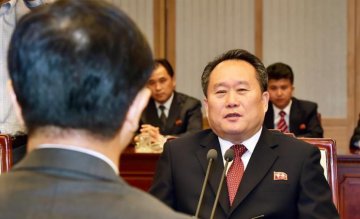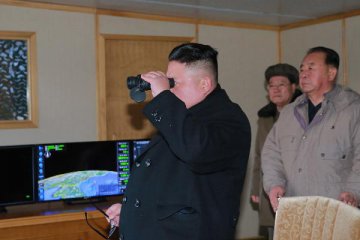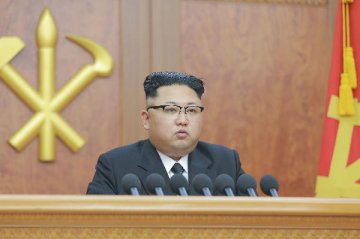South Korea and the Democratic People's Republic of Korea (DPRK) held a groundbreaking ceremony on Wednesday to modernize and connect railways and roads across the inter-Korean border.
The ceremony was held at Panmun Station in the DPRK's border town of Kaesong, attended by some 100 participants from each of the two sides, according to South Korea's unification ministry.
It started at around 10 a.m. local time (0100 GMT) as scheduled to celebrate the groundbreaking, which South Korean President Moon Jae-in and top DPRK leader Kim Jong Un agreed during their Pyongyang summit in September to hold before the end of this year.
Moon and Kim agreed at their first summit in April to modernize and eventually connect railways and roads along the eastern and western Korean Peninsula.
South Korean Minister of Land, Infrastructure and Transport Kim Hyun-mee and Kim Yun Hyok, the vice DPRK railway minister, delivered celebratory speeches as representatives of each side.
From the DPRK side, Ri Son Gwon, chairman of the Committee for the Peaceful Reunification of the Fatherland, and four other high-level officials participated in the event.
Attendees from the South Korean side included Unification Minister Cho Myoung-gyon, Lee Hae-chan, chief of the ruling Democratic Party, and other parliamentary leaders.
Among other South Korean invitees were five civilians, who have families in the DPRK separated by the 1950-53 Korean War, and the last locomotive engineer, who drove the train between Kaesong and Munsan, a South Korean city just south of the border with the DPRK, for about one year until December 2008.
South Korea operated cargo trains five times a week for about one year through the section of the Gyeongui Line from Kaesong to Munsan, but the operation stopped since December 2008 as inter-Korean relations began to sour.
All railways and roads between the two Koreas have been severed since the Korean War ended with an armistice. The Korean Peninsula remains technically at war with the armistice.
Foreign dignitaries also joined the ceremony, including Armida Alisjahbana, executive secretary of the UN Economic and Social Commission for Asia and the Pacific, and senior railway and road officials from neighboring countries.
Kim Kum-ok, a South Korean separated family member whose birthplace is Kaesong, said in the train for the Panmun Station that she rejoiced and was glad at her trip to Kaesong where the 86-year-old spent her early years, according to a pool report from South Korean journalists provided by the unification ministry.
Describing the trip as a dream, Kim said the north-bound train to her hometown had been a big hope to her.
The nine-car train, carrying about 100 South Korean participants, departed from Seoul Station in capital Seoul early Wednesday, and stopped at Dorasan Station, just south of the inter-Korean border, for immigration inspection.
The train crossed the military demarcation line (MDL), which divides the two Koreas, into the DPRK territory at 8:34 a.m. local time (23:34 GMT Tuesday).
After the ceremony, the South Korean participants were scheduled to have lunch in Kaesong and returned by train to the Seoul Station at about 3 p.m. local time (0600 GMT).
The hour-long ceremony was comprised of celebratory speeches from representatives of the two Koreas, the signing on the wooden sleeper, the linking of a track, and the unveiling of a signpost at the station.
The ceremony was held at Panmun Station in the DPRK's border town of Kaesong, attended by some 100 participants from each of the two sides, according to South Korea's unification ministry.
It started at around 10 a.m. local time (0100 GMT) as scheduled to celebrate the groundbreaking, which South Korean President Moon Jae-in and top DPRK leader Kim Jong Un agreed during their Pyongyang summit in September to hold before the end of this year.
Moon and Kim agreed at their first summit in April to modernize and eventually connect railways and roads along the eastern and western Korean Peninsula.
South Korean Minister of Land, Infrastructure and Transport Kim Hyun-mee and Kim Yun Hyok, the vice DPRK railway minister, delivered celebratory speeches as representatives of each side.
From the DPRK side, Ri Son Gwon, chairman of the Committee for the Peaceful Reunification of the Fatherland, and four other high-level officials participated in the event.
Attendees from the South Korean side included Unification Minister Cho Myoung-gyon, Lee Hae-chan, chief of the ruling Democratic Party, and other parliamentary leaders.
Among other South Korean invitees were five civilians, who have families in the DPRK separated by the 1950-53 Korean War, and the last locomotive engineer, who drove the train between Kaesong and Munsan, a South Korean city just south of the border with the DPRK, for about one year until December 2008.
South Korea operated cargo trains five times a week for about one year through the section of the Gyeongui Line from Kaesong to Munsan, but the operation stopped since December 2008 as inter-Korean relations began to sour.
All railways and roads between the two Koreas have been severed since the Korean War ended with an armistice. The Korean Peninsula remains technically at war with the armistice.
Foreign dignitaries also joined the ceremony, including Armida Alisjahbana, executive secretary of the UN Economic and Social Commission for Asia and the Pacific, and senior railway and road officials from neighboring countries.
Kim Kum-ok, a South Korean separated family member whose birthplace is Kaesong, said in the train for the Panmun Station that she rejoiced and was glad at her trip to Kaesong where the 86-year-old spent her early years, according to a pool report from South Korean journalists provided by the unification ministry.
Describing the trip as a dream, Kim said the north-bound train to her hometown had been a big hope to her.
The nine-car train, carrying about 100 South Korean participants, departed from Seoul Station in capital Seoul early Wednesday, and stopped at Dorasan Station, just south of the inter-Korean border, for immigration inspection.
The train crossed the military demarcation line (MDL), which divides the two Koreas, into the DPRK territory at 8:34 a.m. local time (23:34 GMT Tuesday).
After the ceremony, the South Korean participants were scheduled to have lunch in Kaesong and returned by train to the Seoul Station at about 3 p.m. local time (0600 GMT).
The hour-long ceremony was comprised of celebratory speeches from representatives of the two Koreas, the signing on the wooden sleeper, the linking of a track, and the unveiling of a signpost at the station.























Latest comments